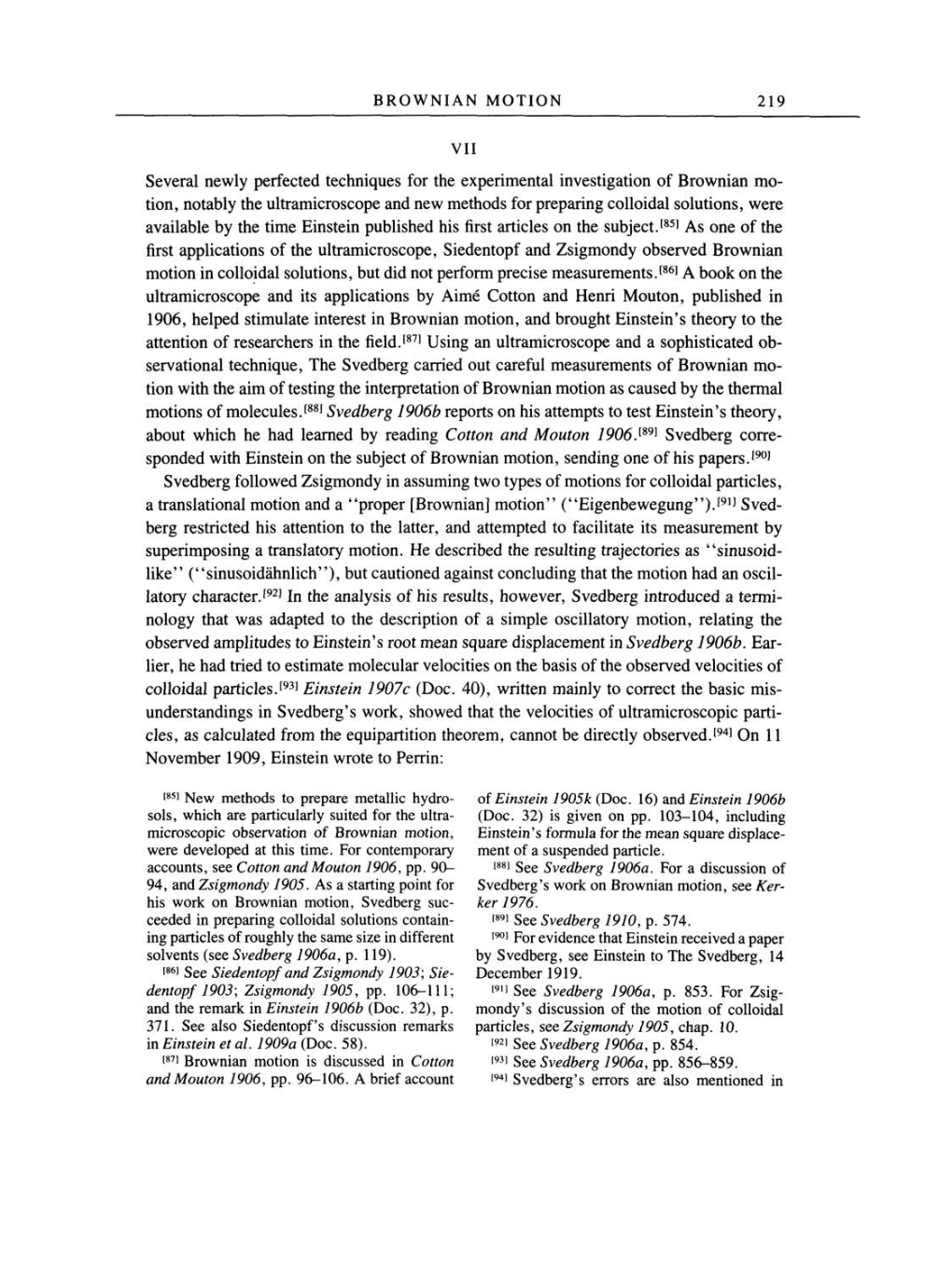BROWNIAN MOTION 219
VII
Several
newly perfected
techniques
for the
experimental
investigation
of
Brownian
mo-
tion,
notably
the
ultramicroscope
and
new
methods
for
preparing
colloidal
solutions,
were
available
by
the time Einstein
published
his
first articles
on
the
subject.[85]
As
one
of
the
first
applications
of
the
ultramicroscope,
Siedentopf
and
Zsigmondy
observed Brownian
motion in colloidal
solutions,
but
did not
perform precise
measurements.[86]
A
book
on
the
ultramicroscope
and its
applications by
Aime Cotton and Henri Mouton,
published
in
1906,
helped
stimulate interest in Brownian
motion,
and
brought
Einstein's
theory
to the
attention
of
researchers in the
field.[87]
Using an ultramicroscope
and
a sophisticated
ob-
servational
technique,
The
Svedberg
carried out careful measurements
of
Brownian
mo-
tion with the aim
of
testing
the
interpretation
of
Brownian motion
as
caused
by
the thermal
motions
of
molecules.[88]
Svedberg
1906b
reports on
his
attempts
to test
Einstein's
theory,
about which he
had learned
by
reading
Cotton
and
Mouton
1906.[89]
Svedberg corre-
sponded
with Einstein
on
the
subject
of
Brownian motion,
sending
one
of
his
papers.[90]
Svedberg
followed
Zsigmondy
in
assuming
two
types
of
motions for colloidal
particles,
a
translational motion and
a
"proper [Brownian]
motion"
("Eigenbewegung").[91]
Sved-
berg
restricted his attention
to
the
latter,
and
attempted
to facilitate its measurement
by
superimposing a translatory
motion. He described the
resulting trajectories as
"sinusoid-
like"
("sinusoidähnlich"),
but cautioned
against concluding
that the motion had
an
oscil-
latory
character.[92] In the
analysis
of
his
results, however,
Svedberg
introduced
a
termi-
nology
that
was adapted
to the
description
of
a simple oscillatory
motion,
relating
the
observed
amplitudes
to
Einstein's
root
mean square displacement
in
Svedberg
1906b. Ear-
lier,
he had tried to estimate molecular velocities
on
the basis
of
the observed velocities
of
colloidal
particles.[93]
Einstein 1907c
(Doc. 40),
written
mainly
to correct the
basic mis-
understandings
in Svedberg's
work,
showed that the
velocities
of
ultramicroscopic parti-
cles,
as
calculated from the
equipartition theorem,
cannot be
directly
observed.[94] On
11
November
1909,
Einstein
wrote to Perrin:
[85]
New methods to
prepare
metallic
hydro-
sols,
which
are particularly
suited for the ultra-
microscopic
observation
of
Brownian
motion,
were developed
at
this time. For
contemporary
accounts,
see
Cotton
and
Mouton
1906,
pp.
90-
94,
and
Zsigmondy
1905. As
a starting point
for
his work
on
Brownian
motion,
Svedberg suc-
ceeded in
preparing
colloidal solutions contain-
ing particles
of
roughly
the
same
size in different
solvents
(see
Svedberg
1906a,
p.
119).
[86]
See
Siedentopf
and
Zsigmondy
1903;
Sie-
dentopf 1903;
Zsigmondy
1905,
pp.
106-111;
and the remark in Einstein 1906b
(Doc. 32), p.
371. See also
Siedentopf's
discussion remarks
in
Einstein
et
al.
1909a
(Doc. 58).
[87]
Brownian motion
is
discussed in Cotton
and
Mouton
1906,
pp.
96-106.
A
brief
account
of Einstein 1905k
(Doc.
16)
and Einstein 1906b
(Doc. 32) is
given on pp.
103-104,
including
Einstein's
formula for the
mean square displace-
ment
of
a
suspended particle.
[88]
See
Svedberg
1906a. For
a
discussion of
Svedberg's
work
on
Brownian
motion,
see
Ker-
ker
1976.
[89]
See
Svedberg 1910, p.
574.
[90]
For evidence that Einstein
received
a
paper
by
Svedberg, see
Einstein to
The
Svedberg, 14
December
1919.
[91]
See
Svedberg 1906a, p.
853. For
Zsig-
mondy's discussion
of
the motion
of
colloidal
particles,
see Zsigmondy 1905,
chap.
10.
[92]
See
Svedberg 1906a,
p.
854.
[93]
See
Svedberg 1906a,
pp.
856-859.
[94]
Svedberg's
errors
are
also mentioned in
